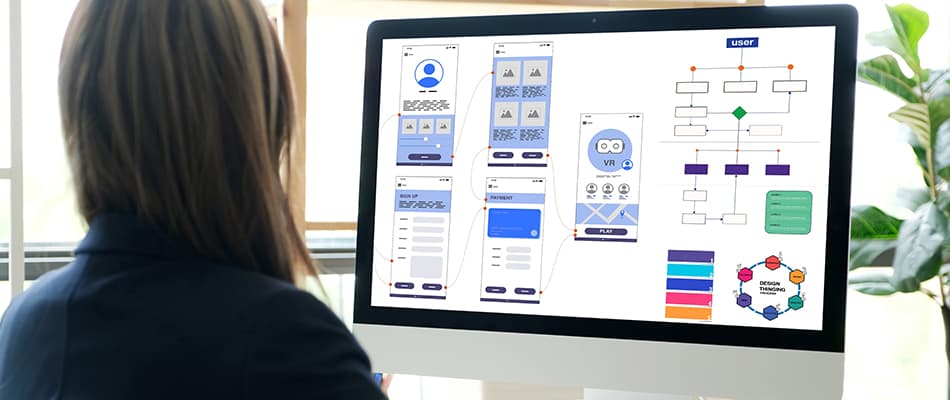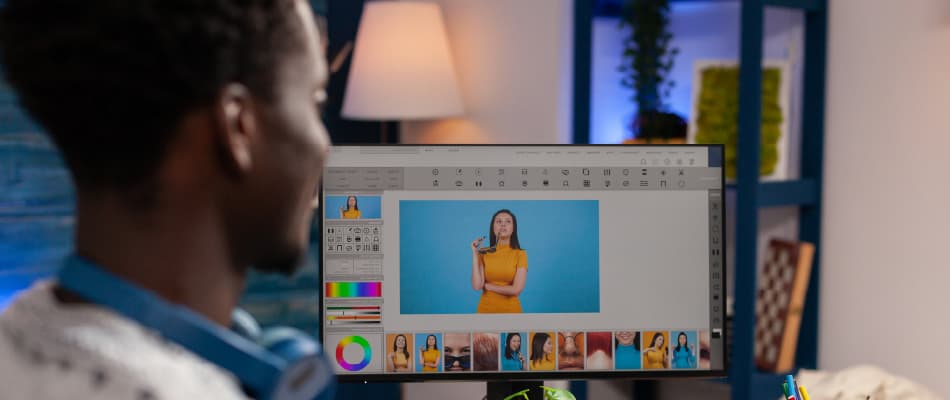Graphic Design vs Web Design: Understanding the Major Differences and Similarities
Graphic design is the art of creating visual content to communicate messages, while web design focuses on building and designing user-friendly, interactive websites. In the creative world, choosing the right career can be challenging, especially between graphic design and web design.
Understanding graphic design vs web design is crucial for anyone looking to pursue a career in visual arts. While both disciplines involve visual storytelling and creativity, they have unique purposes, techniques, and skill sets. Graphic design focuses on creating visually appealing static visuals for print and digital media, while web design emphasises building interactive and user-friendly websites.
Read the article to learn more about graphic design vs web design, their similarities, career opportunities and more.
What is Graphic Design?
Graphic design is a profession focused on creating visual communications to convey specific messages to social groups. It is an interdisciplinary branch of design and fine arts involving creativity, innovation, and the use of manual or digital tools. Graphic design uses text, typography, and imagery to communicate ideas, emotions, and attitudes beyond language alone.
It transforms linguistic messages into visual forms. This field can be applied to various areas, including advertising, aviation, and even space exploration. Often associated with sketches and drawings, graphic design is a broad field encompassing many applications. It has evolved from its origins in the printing boom of the 15th century to a vital profession today.
Learn what is graphic design in detail here
What is Web Design?
Web design is the process of creating and arranging content on websites. It involves designing the layout, user interface, and overall appearance to ensure a positive user experience. Web design focuses on both the visual and functional aspects, including site structure, responsiveness, and accessibility. It uses various tools and techniques to create websites that are visually appealing and easy to use.
When exploring graphic design vs web design, it is important to note that graphic design focuses on creating static visual content. In contrast, web design emphasises creating interactive and user-friendly online experiences.
Although graphic design and web design share some creative principles, web design also requires knowledge of user behaviour, site structure, and accessibility. Both fields value creativity and aesthetic appeal, but web design must ensure usability and performance to create effective online experiences.
Difference Between Graphic Design and Web Design
If you are considering a career in graphic design and web design, it’s essential to understand the unique characteristics of each discipline. The difference between graphic design and web design lies in their purpose, tools, and applications. While both aim to communicate visually, they serve distinct roles in designing and addressing different needs and audiences. Let us explore graphic design vs web design below:
|
Aspect |
Graphic Design |
Web Design |
|
Purpose |
Graphic design focuses on creating visual content for print and digital media to convey messages. |
Web design focuses on building and organising website content to provide a functional and user-friendly experience. |
|
Medium |
Graphic design is used for physical or static digital formats like posters, flyers, and brochures. |
Web design is specifically meant for online platforms, including websites and mobile applications. |
|
Interactivity |
Graphic design is often static and does not involve user interaction. |
Web design requires interactive elements like buttons, links, and menu bars. |
|
Skills |
Graphic design involves skills in typography, colour theory, and layout design. |
Web design requires knowledge of HTML, CSS, and user experience (UX) principles. |
|
Tools |
Graphic designers frequently use tools like Adobe Illustrator and Photoshop. |
Web designers often use tools like Adobe XD, Sketch, and web development software. |
|
Functionality |
Graphic design is aimed at making content visually appealing to communicate a message. |
Web design prioritises functionality and usability to ensure a smooth user experience on different devices. |
Similarities Between Graphic Design and Web Design
After understanding graphic design vs web design, it is equally important to explore their similarities to see how these fields overlap and complement each other. Despite their unique applications and purposes, these two fields share some common principles. Let us know some similarities between graphic design and web design below:
- Both graphic design and web design focus on visual communication.
- They use similar design elements like colour, typography, and imagery.
- Both fields require strong composition and layout skills.
- Graphic design and web design prioritise engaging and appealing visuals.
- Graphic design and web design often use design software like Adobe Creative Suite.
- They need a good understanding of target audiences to be effective.
- Both require creative thinking and problem-solving.
Graphic Design vs Web Design- Career Opportunities in Both Fields
After understanding the differences and similarities between graphic design and web design, you can explore the career opportunities in each field. Both fields have unique roles, while some positions require a combination of skills from both areas. Let us look at the graphic design vs web design job roles below:
1. Graphic Design Roles:
- Graphic Designer: Creates visual concepts to communicate ideas through print and digital media.
- Motion Graphics Designer: Creates animated visuals for videos, presentations, and digital platforms.
- Digital Illustrator: Designs and creates digital images for various online and offline projects.
2. Web Design Roles:
- Web Designer: Focuses on creating visually appealing and user-friendly websites.
- Front-End Developer: Combines web design with coding to create the visual and interactive parts of websites using HTML, CSS, and JavaScript.
- Back-End Developer: Manages server-side operations and databases to ensure smooth website functionality.
3. Overlapping Roles:
- Multimedia Designer: Combines graphic design and web design skills to create interactive content.
- Visual Designer: Focuses on visual elements across digital and print media, blending graphic design and web design principles.
- UX/UI Designer: Combines graphic and web design to improve user experience and interface, ensuring functionality and aesthetics work seamlessly.
Learn advertising vs graphic design here
Graphic Design vs Web Design- Which One Should You Choose?
If you are considering a career in the creative industry, deciding between graphic design and web design can be challenging. Each path has its unique set of skills, interests, and opportunities. Let us look at which field might be a better fit for you based on your preferences and strengths.
1. Graphic Design is for You If
- You enjoy creating static visuals and working on branding campaigns.
- You have a strong artistic flair and attention to detail.
- You like working with typography, colour schemes, and composition.
- You prefer working on print projects like posters, brochures, and flyers.
- You enjoy conveying messages visually through illustrations and imagery.
2. Web Design is for You If
- You are interested in interactive platforms and digital user experiences.
- You enjoy problem-solving and working with code.
- You want to create websites that are both functional and visually appealing.
- You enjoy learning and working with different web development tools and software.
- You like focusing on user flow and improving website usability.
Why Study UI/UX and Graphic Design Course at Digital Regenesys?
When choosing a course to advance your design career, you need to assess many factors. Digital Regenesys is one of the best options due to its expert-led sessions, hands-on projects and many other benefits. Their UI/UX and Graphic Design Course with GenAI offers practical training and valuable industry insights, ensuring you gain the skills needed. Let us look at some more reasons to study graphic design with Digital Regenesys below:
- Gain practical training in graphic design and UI/UX.
- Learn essential design principles and strategies.
- Learn industry-leading tools like Adobe Creative Cloud and Figma.
- Develop skills in mobile app and web design.
- Hands-on projects to apply learning.
- Understand graphic design vs web design.
- Expert instructors with real-world experience.
- Get certified with a globally recognised qualification.
- Build a strong design portfolio.
- Access career guidance and support.
- Learn generative AI techniques for modern design.
Choosing a graphic design vs web design career can shape your creative career. Despite the differences, both fields value creativity, strong visual skills, and clear communication. If you are ready to upskill your design expertise, consider Digital Regenesys’s UI/UX and Graphic Design course. You’ll be well-prepared to excel with hands-on training, industry-leading tools, and expert support. Take the first step and enrol in the course to advance your career in design.
Graphic Design vs Web Design – FAQs
What is the main difference between graphic design and web design?
Graphic design focuses on creating static visuals for print and digital media, while web design involves building interactive, user-friendly websites.
What tools are commonly used in graphic design?
Graphic designers often use Adobe Illustrator and Photoshop.
What skills are essential for web design?
Web design requires knowledge of HTML, CSS, and user experience (UX) principles.
How do graphic design and web design overlap?
Both fields use similar design elements like colour, typography, and imagery and require strong composition skills.
What type of projects do graphic designers work on?
Graphic designers create projects like posters, flyers, and brochures.
What roles are available in web design?
Web design roles include web designer, UI/UX designer, and front-end developer.














